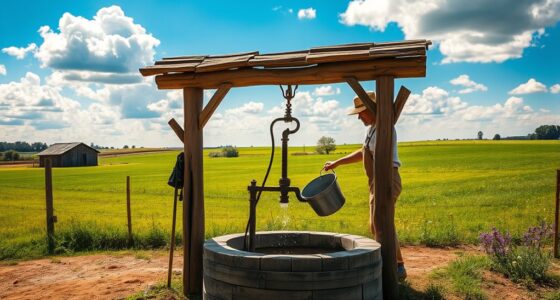To improve food security through sustainable gardening, focus on building healthy soil with composting, practicing crop rotation, and selecting native or drought-tolerant plants to reduce water and fertilizer needs. Use water-saving techniques like rainwater harvesting and mulching to conserve resources. Incorporate organic pest management and diversify plantings to boost resilience. Establish community gardens to increase local food access. Keep exploring for more ideas to create a thriving, eco-friendly garden that feeds your community.
Key Takeaways
- Implement crop rotation and polyculture planting to enhance soil health and reduce pest outbreaks.
- Use native, drought-resistant plants and water-saving techniques like drip irrigation and rainwater harvesting.
- Build healthy soil with composting, organic amendments, and mulching to improve productivity and resilience.
- Promote biodiversity by planting beneficial flowers and attracting pollinators to support sustainable food production.
- Engage communities through urban gardens, educational workshops, and shared efforts to increase local food security.
Building Healthy Soil Through Composting

Building healthy soil through composting is one of the most effective ways to improve your garden’s fertility naturally. To start, conduct soil testing to understand your soil’s current nutrient levels and pH. This helps you tailor your compost mix for *ideal* results. When designing your compost bin, choose a structure that allows good airflow, drainage, and easy access for turning materials. A well-designed compost bin encourages microbial activity, speeding up the decomposition process. Use a mix of green materials like fruit scraps and grass clippings, along with browns such as leaves and cardboard. Regularly monitor moisture and aerate the compost to keep it active. Incorporating nutrient-rich ingredients into your compost will further boost its effectiveness and benefits. Additionally, adding organic matter can enhance microbial growth and improve soil health over time. Proper compost management ensures efficient decomposition and higher-quality compost. Incorporating diverse carbon and nitrogen sources promotes a balanced compost ecosystem, leading to richer soil amendment outputs. Moreover, understanding composting techniques helps optimize the process for better results. Over time, this process will produce rich, nutritious compost that enhances your soil’s structure and fertility, supporting healthier plant growth.
Implementing Crop Rotation for Better Yields

After enriching your soil with compost, implementing crop rotation can further boost your garden’s productivity. By practicing crop sequencing, you prevent soil nutrient depletion and reduce pest buildup. Rotate crops based on their families, such as legumes, root vegetables, and leafy greens, to promote crop diversity. This approach helps break disease cycles and minimizes the need for chemical interventions. You’ll notice healthier plants and improved yields because different crops draw on different nutrients and contribute uniquely to soil health. Additionally, integrating organic seed cultivation practices enhances overall sustainability and soil vitality. Incorporating soil health management techniques can further improve nutrient retention and microbial activity in your garden. Using crop rotation strategies effectively supports long-term soil fertility and crop resilience. Regularly monitoring soil conditions allows you to adjust your practices for optimal results. Keeping detailed records of your planting patterns and crop sequencing ensures effective rotation over successive seasons. With thoughtful crop rotation, you create a resilient garden that sustains itself over time, supporting food security while maintaining ecological balance.
Choosing Native and Drought-Resistant Plants

Choosing native and drought-resistant plants is one of the most effective ways to create a sustainable garden. Native plant selection guarantees your garden thrives with local species that are adapted to your environment, reducing the need for extra water, fertilizers, and pesticides. These plants are naturally resilient, requiring less maintenance and helping to conserve resources. Incorporating drought resistant landscaping techniques means selecting plants that can withstand dry conditions, making your garden more resilient during periods of limited rainfall. By focusing on native and drought-tolerant plants, you promote biodiversity, support local ecosystems, and minimize water consumption. Additionally, plant diversity enhances the resilience of your garden against pests and climate fluctuations. This approach not only saves resources but also creates a sustainable, low-maintenance garden that contributes to long-term food security while reducing your ecological footprint. Employing community-based gardening strategies can further strengthen local food systems and foster shared sustainability efforts. Developing an understanding of ecological principles can help you design a garden that harmonizes with natural processes and promotes sustainability. Furthermore, utilizing AI-powered tools can assist in selecting the most suitable native and drought-resistant plants for your specific region and soil conditions.
Water Conservation Techniques for Sustainable Growth

To conserve water in your garden, consider installing drip irrigation systems that deliver water directly to plant roots. Mulching helps retain soil moisture and reduces evaporation, while rainwater harvesting provides an eco-friendly source of irrigation. Implementing these techniques can markedly boost your garden’s sustainability and growth. Additionally, selecting energy-efficient watering methods can further reduce water waste and improve overall garden health.
Drip Irrigation Systems
Have you considered how drip irrigation systems can substantially reduce water waste in your garden? Drip irrigation enhances water efficiency by delivering water directly to plant roots, minimizing evaporation and runoff. This targeted approach ensures your plants receive the right amount of moisture, conserving precious water resources. To maximize benefits, you can:
- Adjust emitters to suit different plant needs for ideal water use
- Schedule watering times early in the morning or late evening to reduce evaporation
- Incorporate timers for consistent, automated watering and improved water management
- Regularly monitor and clean emission emitters to maintain optimal water flow and efficiency
Using drip irrigation not only conserves water but also promotes healthier plants, reduces weed growth, and lowers your overall water bills. It’s an essential water conservation technique for sustainable growth and food security.
Mulching for Moisture
Ever wonder how mulching can help your garden retain more moisture? Mulching acts as a protective layer that reduces water evaporation from the soil, keeping roots hydrated longer. When choosing mulch, consider color options like dark bark or black plastic, which absorb heat and help warm the soil, or lighter colors that reflect sunlight, keeping soil cooler. Organic mulch types, such as straw, wood chips, or compost, improve soil health while conserving water. These natural options break down over time, enriching your soil and reducing the need for frequent watering. Applying a 2-3 inch layer of mulch around plants minimizes moisture loss, especially during hot weather. Mulching not only conserves water but also suppresses weeds, supporting sustainable growth and food security. For optimal results, select mulching materials that are compatible with solar-powered garden tools to further enhance your eco-friendly gardening practices.
Rainwater Harvesting
Did you know that harvesting rainwater is one of the simplest and most effective ways to conserve water in your garden? By collecting rainwater in harvesting containers, you can improve rainwater purity and reduce reliance on municipal supplies. Properly designed systems prevent contamination and ensure clean water for your plants. Using suitable containers also minimizes evaporation and runoff. To optimize your rainwater harvesting, consider:
- Installing filters at collection points to maintain rainwater purity
- Choosing dark-colored, sealed harvesting containers to prevent algae growth
- Positioning containers on stable, elevated surfaces for better water flow
- Incorporating Kia Tuning techniques to enhance the durability and efficiency of your harvesting systems
Implementing these practices helps you maximize water efficiency, supports sustainable growth, and reduces your environmental footprint. Rainwater harvesting is a simple yet powerful step toward a resilient, eco-friendly garden.
Utilizing Organic Pest Management Strategies

Utilizing organic pest management strategies offers an effective way to protect your garden without relying on synthetic chemicals. You can encourage natural pest control by attracting beneficial insects like ladybugs and lacewings, which prey on pests. Compost tea acts as a natural foliar spray that boosts plant health and deters pests. Incorporate these methods into your routine for sustainable results. Here’s a quick guide:
| Strategy | Benefits |
|---|---|
| Compost Tea | Enhances plant immunity and reduces pest attraction |
| Beneficial Insects | Naturally control pest populations |
| Crop Rotation | Prevents pest buildup |
| Companion Planting | Deters pests through plant diversity |
A proper understanding of pest control techniques can further improve your garden’s resilience and promote sustainable gardening practices. Using integrated pest management, which combines multiple organic strategies, can optimize your efforts and ensure a healthy, productive garden. Additionally, staying informed about crop health monitoring can help you catch pest issues early and maintain a thriving garden. Proper soil health practices also play a crucial role in supporting plant defenses against pests and diseases.
Creating Polyculture Gardens to Enhance Biodiversity

Building a polyculture garden by mixing different plant species not only complements organic pest management but also boosts overall biodiversity. With greater plant diversity, you create diverse pollinator habitats that attract bees, butterflies, and other beneficial insects. This natural support system lessens the need for chemical interventions and enhances crop resilience. To maximize benefits, consider planting a variety of flowering species alongside vegetables and herbs. Incorporate native plants to support local pollinators and improve ecosystem stability. A diverse garden fosters ecological balance and ensures a more sustainable food supply. Key strategies include:
- Selecting a mix of annuals and perennials for continuous bloom periods
- Incorporating flowering plants that attract pollinators year-round
- Designing plant arrangements that mimic natural habitats, encouraging diverse insect populations
- Utilizing hybrid plant varieties that are better adapted to local conditions and support biodiversity.
Incorporating Mulching to Preserve Moisture and Suppress Weeds

Mulching helps you retain soil moisture, reducing the need for frequent watering. It also acts as a natural barrier, keeping weeds from taking over your garden beds. Choosing the right mulch material can boost these benefits and support your sustainable gardening goals. Additionally, using self-watering plant pots can further minimize water usage by providing consistent moisture directly to your plants.
Moisture Retention Benefits
Applying mulch around your plants is an effective way to keep soil moist and reduce the need for frequent watering. This practice enhances the soil’s moisture retention benefits by creating a barrier that minimizes evaporation. Improved soil moisture helps plants stay healthy, especially during dry periods, and supports consistent nutrient uptake. Mulching also moderates soil temperature, preventing rapid drying and temperature fluctuations that can stress your plants. To maximize these benefits, choose appropriate mulch materials and apply a sufficient layer.
- Maintains consistent soil moisture levels for healthier plants
- Reduces watering frequency, conserving water resources
- Protects against soil temperature extremes, promoting retention benefits
Weed Suppression Techniques
Have you considered how mulching can effectively suppress weeds while conserving moisture in your garden? By applying a thick layer of mulch, you create a barrier that blocks weed seeds from reaching sunlight, reducing their growth. Incorporate mulch layering around your plants to keep the soil moist and inhibit weed emergence. To boost your weed suppression efforts, you can water your mulch with compost tea, which enriches the soil and promotes healthy plant growth, outcompeting weeds naturally. Regularly replenishing mulch layers ensures continuous weed suppression and moisture retention. This simple technique minimizes the need for chemical weed killers and enhances your garden’s sustainability. With consistent mulch layering and compost tea applications, you create a resilient, weed-resistant garden that supports food security.
Mulch Material Choices
What materials you choose for mulch can considerably impact your garden’s ability to retain moisture and suppress weeds. Organic options like straw, wood chips, or shredded leaves are excellent for mulch layering, providing nutrients as they decompose. Incorporating compost from your compost bin enhances soil fertility and aids in moisture retention. When selecting mulch, consider local availability and sustainability; locally sourced materials reduce environmental impact. You can also mix different mulch types to improve effectiveness and soil health. Proper mulch layering ensures even coverage, preventing weeds and conserving water. Avoid thick layers of plastic or non-biodegradable materials that can hinder soil health. Your choices directly influence your garden’s resilience, sustainability, and productivity.
Using Rainwater Harvesting Systems

Did you know that harvesting rainwater can considerably reduce your reliance on municipal water supplies and lower your water bills? Installing a rainwater harvesting system helps you collect and store rainwater from roofs or other surfaces, making it a valuable resource for your garden. This practice also enhances stormwater management by minimizing runoff that can cause erosion or flooding. By capturing rainwater, you reduce the strain on local water sources and promote sustainability. Using stored rainwater for irrigation is cost-effective and environmentally friendly, especially during dry seasons. Properly designed systems include gutters, filters, and storage tanks to ensure clean, accessible water. Embracing rainwater harvesting supports your garden’s health while contributing to broader water conservation efforts.
Promoting Community Gardens for Local Food Production

Harnessing the benefits of rainwater harvesting can inspire communities to work together toward shared sustainability goals, such as promoting local food production through community gardens. These gardens support urban farming efforts, making fresh produce accessible and reducing reliance on external food sources. By participating in community gardens, you boost community engagement and foster a sense of ownership among residents. To maximize impact, consider:
- Providing educational workshops on sustainable urban farming methods
- Creating volunteer opportunities to maintain and expand gardens
- Collaborating with local organizations to secure resources and funding
Engaging residents in these activities encourages local food production and builds resilient neighborhoods. Community gardens serve as crucial hubs for learning, cooperation, and sustainable urban farming practices, helping communities grow their own food while strengthening social bonds.
Leveraging Permaculture Principles for Resilient Gardens

You can create a more resilient garden by designing diverse ecosystems that support various plants and wildlife. Zone planning helps you organize your space efficiently, placing resources where they’re most needed. By applying these permaculture principles, you build a sustainable garden that thrives with less intervention.
Designing Diverse Ecosystems
How can you create a resilient garden that mimics natural ecosystems? By designing diverse ecosystems, you foster ecological balance and support native habitats. Incorporate a variety of plants, animals, and microbes to create a self-sustaining system that resists pests and weather extremes. Focus on native species, as they thrive locally and support local biodiversity. Use layered planting strategies to maximize space and resources, mimicking natural forest or meadow structures. Diversification reduces dependency on external inputs and enhances resilience against disturbances. Consider the roles different species play, from nitrogen fixers to pollinators, ensuring each contributes to the overall health of your garden. Achieving this ecological harmony results in a vibrant, sustainable food-producing environment that naturally stabilizes itself over time.
Implementing Zone Planning
Implementing zone planning is a practical way to organize your garden for maximum efficiency and resilience, drawing on permaculture principles. Begin by evaluating your site through soil testing to understand soil health and nutrient levels, guiding your plant selection. Place frequently used herbs and vegetables in Zone 1, close to your home, to make maintenance easier. Less demanding plants, like fruit trees, can go in Zone 2 or 3, where they require less frequent attention. Use your soil testing results to choose plants suited to each zone’s conditions, reducing the need for extra inputs like water and fertilizers. This strategic placement minimizes energy use, enhances productivity, and creates a resilient, sustainable garden tailored to your environment.
Frequently Asked Questions
How Can Urban Residents Implement Sustainable Gardening Practices Effectively?
You can effectively implement sustainable gardening in urban areas by starting with container planting, which saves space and reduces soil contamination. Incorporate urban composting to recycle kitchen scraps, enriching your soil naturally. Use eco-friendly practices like rainwater harvesting and organic pest control. These methods promote healthy growth and conserve resources, making your urban garden more sustainable. Ultimately, small, consistent efforts can notably improve your food security and environmental impact.
What Are the Economic Benefits of Sustainable Gardening for Small-Scale Farmers?
The current question highlights the economic edge sustainable gardening offers small-scale farmers. You’ll notice cost savings through efficient resource use, reducing expenses on inputs. Plus, market opportunities expand as eco-friendly practices attract conscious consumers. This combination boosts your income and fosters financial resilience. Embracing sustainability not only safeguards the environment but also strengthens your economic stability, making your farming venture more profitable and prosperous in the long run.
How Does Sustainable Gardening Impact Local Ecosystems and Biodiversity?
You’ll see that sustainable gardening positively impacts local ecosystems and biodiversity. By choosing native plants, reducing chemical use, and practicing crop rotation, you help preserve biodiversity and promote ecosystem stability. These methods minimize harm to beneficial insects, birds, and soil organisms, creating a balanced environment. As a result, your garden becomes a thriving habitat that supports diverse species, ensuring long-term ecosystem health and resilience for your community.
What Are Common Challenges Faced When Adopting Sustainable Gardening Methods?
When adopting sustainable gardening methods, you often face challenges like managing pests without harmful chemicals and maintaining soil fertility naturally. Pests can quickly damage your crops, and finding eco-friendly solutions takes experimentation. Additionally, preserving soil health requires careful composting and crop rotation. These hurdles demand patience and learning but are essential for creating a resilient, eco-conscious garden that supports long-term food security.
How Can Schools Incorporate Sustainable Gardening Into Their Educational Programs?
Imagine transforming your school into a lush, green classroom! To do this, you can incorporate sustainable gardening into your educational integration by creating hands-on projects, eco-friendly gardens, and outdoor lessons. This sparks student engagement, making learning exciting and meaningful. By involving students in planting, composting, and maintaining gardens, you turn sustainability into an unforgettable experience that cultivates environmental awareness and responsibility.
Conclusion
By adopting these sustainable gardening practices, you can cultivate a resilient food system that blooms like a vibrant garden in spring. Think of your efforts as planting seeds of change—each step you take helps build a healthier, more secure future. With patience and dedication, your garden becomes a sanctuary of abundance, nourishing not just your table but the entire community. Together, you’re nurturing the roots of food security for generations to come.










